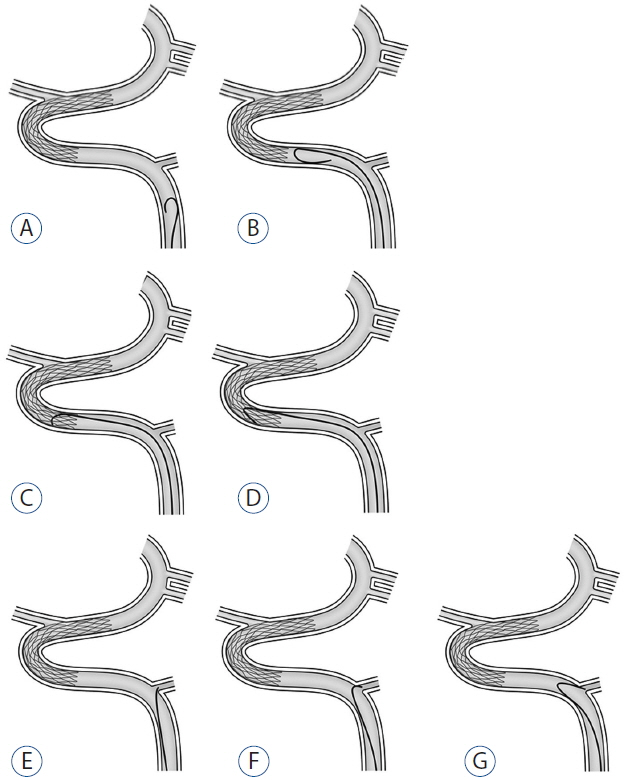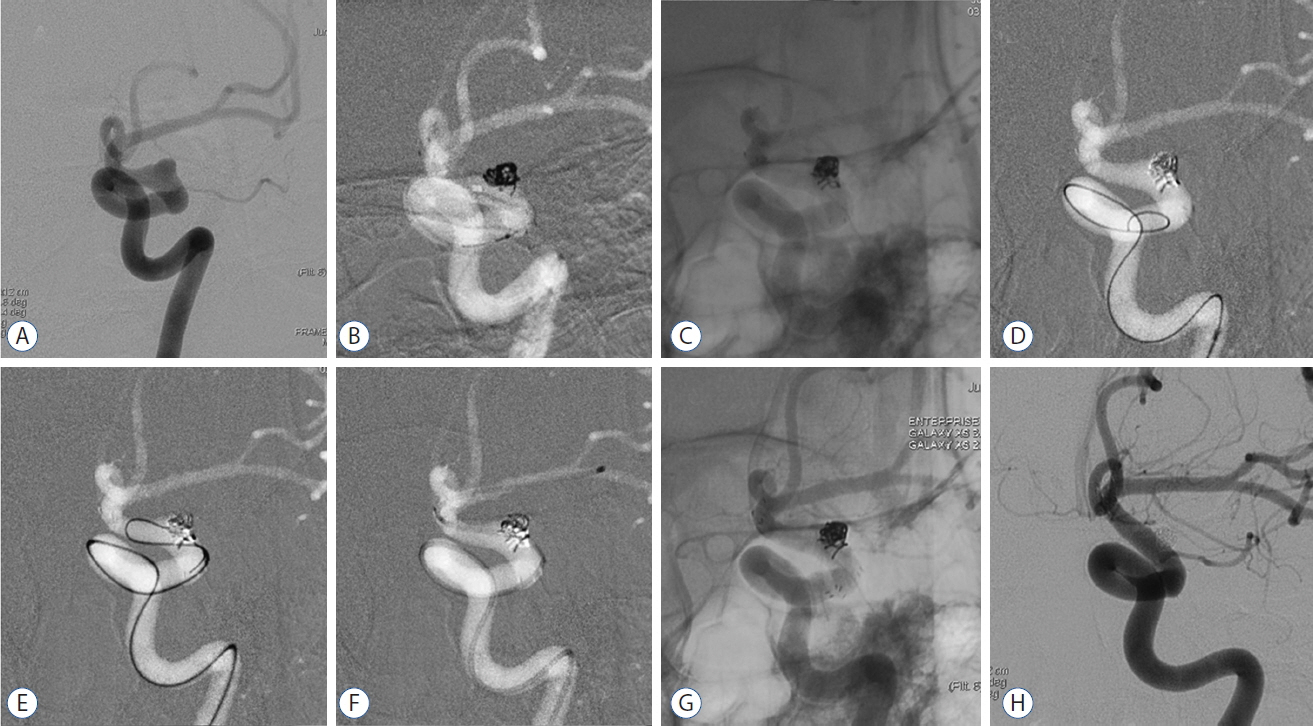J Korean Neurosurg Soc.
2017 Feb;60(2):262-268. 10.3340/jkns.2016.0707.009.
Microguidewire Looping to Traverse Stented Parent Arteries of Intracranial Aneurysms
- Affiliations
-
- 1Department of Radiology, Seoul National University Hospital, Seoul National University College of Medicine, Seoul, Korea.
- 2Department of Neurosurgery, Seoul National University Hospital, Seoul National University College of Medicine, Seoul, Korea. ydofmh@gmail.com
- KMID: 2374890
- DOI: http://doi.org/10.3340/jkns.2016.0707.009
Abstract
OBJECTIVE
Stents are widely used in coil embolization of intracranial aneurysms, but on occasion, a microcatheter must traverse a stented segment of artery (so-called trans-cell technique) to select an aneurysm, or double stenting may necessary. In such situations, microguidewire passage and microcatheter delivery through a tortuous stented parent artery may pose a technical challenge. Described herein is a microguidewire looping technique to facilitate endovascular navigation in these circumstances.
METHODS
To apply this technique, the microguidewire tip is looped before entering the stented parent artery and then advanced distally past the stented segment, with the loop intact. Rounding of the tip prevents interference from stent struts during passage. A microcatheter is subsequently passed into the stented artery for positioning near the neck of aneurysm, with microguidewire assistance. The aneurysm is then selected, steering the microcatheter tip (via inner microguidewire) into the dome.
RESULTS
This technique proved successful during coil embolization of nine saccular intracranial aneurysms (internal carotid artery [ICA], 6; middle cerebral artery, 2; basilar tip, 1), performing eight trans-cell deliveries and one additional stenting. Selective endovascular embolization was enabled in all patients, resulting in excellent clinical and radiologic outcomes, with no morbidity or mortality directly attributable to microguidewire looping.
CONCLUSION
Microguidewire looping is a reasonable alternative if passage through a stented artery is not feasible by traditional means, especially at paraclinoid ICA sites.
Keyword
MeSH Terms
Figure
Reference
-
References
1. Benndorf G, Bender A, Lehmann R, Lanksch W. Transvenous occlusion of dural cavernous sinus fistulas through the thrombosed inferior petrosal sinus: report of four cases and review of the literature. Surg Neurol. 54:42–54. 2000.
Article2. Chalouhi N, Jabbour P, Singhal S, Drueding R, Starke RM, Dalyai RT, et al. Stent-assisted coiling of intracranial aneurysms: predictors of complications, recanalization, and outcome in 508 cases. Stroke. 44:1348–1353. 2013.3. Cho YD, Kang HS, Kim JE, Son YJ, Lee JY, Lee SJ, et al. Microcatheter looping technique for coil embolization of complex configuration middle cerebral artery aneurysms. Neurosurgery. 71:1185–1191. discussion 1191. 2012.
Article4. Cho YD, Lee JY, Seo JH, Lee SJ, Kang HS, Kim JE, et al. Does stent implantation improve the result of repeat embolization in recanalized aneurysms? Neurosurgery. 71(2 Suppl Operative):ons253–ons259. discussion ons259. 2012.
Article5. Cho YD, Park SW, Lee JY, Lee JY, Seo JH, Kang HS, et al. Nonoverlapping Y-configuration stenting technique with dual closed-cell stents in wide-neck basilar tip. Neurosurgery. 70(2 Suppl Operative):244–249. 2012.6. Cho WS, Kang HS, Kim JE, Kwon OK, Oh CW, Cho YD, et al. Angle change of the parent arteries after stent-assisted coil embolization of wide-necked intracranial bifurcation aneurysms. Clin Radiol. 69:e63–e70. 2014.
Article7. Gory B, Klisch J, Bonafé A, Mounayer C, Beaujeux R, Moret J, et al. Solitaire AB stent-assisted coiling of wide-necked intracranial aneurysms: short-term results from a prospective, consecutive, European multicentric study. Neuroradiology. 55:1373–1378. 2013.
Article8. Heller RS, Malek AM. Parent vessel size and curvature strongly influence risk of incomplete stent apposition in enterprise intracranial aneurysm stent coiling. AJNR Am J Neuroradiol. 32:1714–1720. 2011.
Article9. Heller RS, Safain M, Malek AM. Double-barrel entanglement of intracranial Enterprise stents resulting from undetected incomplete stent apposition. J Neurointerv Surg. 4:e38. 2012.
Article10. Juszkat R, Nowak S, Smól S, Kociemba W, Blok T, Zarzecka A. Leo stent for endovascular treatment of broad-necked and fusiform intracranial aneurysms. Interv Neuroradiol. 13:255–269. 2007.
Article11. Kang HS, Kwon BJ, Kim JE, Han MH. Preinterventional clopidogrel response variability for coil embolization of intracranial aneurysms: clinical implications. AJNR Am J Neuroradiol. 31:1206–1210. 2010.
Article12. Kulcsár Z, Göricke SL, Gizewski ER, Schlamann M, Sure U, Sandalcioglu IE, et al. Neuroform stent-assisted treatment of intracranial aneurysms: long-term follow-up study of aneurysm recurrence and in-stent stenosis rates. Neuroradiology. 55:459–465. 2013.
Article13. Lawson MF, Newman WC, Chi YY, Mocco JD, Hoh BL. Stent-associated flow remodeling causes further occlusion of incompletely coiled aneurysms. Neurosurgery. 69:598–603. 2011.
Article14. Lee SJ, Cho YD, Kang HS, Kim JE, Han MH. Coil embolization using the self-expandable closed-cell stent for intracranial saccular aneurysm: a single-center experience of 289 consecutive aneurysms. Clin Radiol. 68:256–263. 2013.
Article15. Liu H, Choe J, Jung SC, Song Y, Yang KH, Park KJ, et al. Does a low-wall coverage stent have a flow diverting effect in small aneurysms? Neurointervention. 10:89–93. 2015.
Article16. Lubicz B. Linear stent-assisted coiling: another way to treat very wide-necked intracranial aneurysms. Neuroradiology. 53:457–459. 2011.
Article17. Park KY, Kim BM, Kim DJ. Comparison between balloon-assisted and stent-assisted technique for treatment of unruptured internal carotid artery aneurysms. Neurointervention. 11:99–104. 2016.
Article18. Park W, Song Y, Park KJ, Koo HW, Yang K, Suh DC. Hemodynamic characteristics regarding recanalization of completely coiled aneurysms: Computational fluid dynamic analysis using virtual models comparison. Neurointervention. 11:30–36. 2016.
Article19. Piotin M, Blanc R, Spelle L, Mounayer C, Piantino R, Schmidt PJ, et al. Stent-assisted coiling of intracranial aneurysms: clinical and angiographic results in 216 consecutive aneurysms. Stroke. 41:110–115. 2010.20. Roy D, Milot G, Raymond J. Endovascular treatment of unruptured aneurysms. Stroke. 32:1998–2004. 2001.
Article21. Yashar P, Kan PT, Levy EI. Horizontal deployment of an intracranial stent via an antegrade approach for coil embolization of a basilar apex aneurysm: technical note. J Neurointerv Surg. 3:355–357. 2011.
Article
- Full Text Links
- Actions
-
Cited
- CITED
-
- Close
- Share
- Similar articles
-
- Discrepancy between Angiography and Operative Findings of Small Side Wall Aneurysms in Atherosclerotic Parent Arteries
- Multiple Cerebral Aneurysms on Single Parent Artery
- Microcatheter Looping to Facilitate Aneurysm Selection in Coil Embolization of Paraclinoid Aneurysms
- Guidewire Breakage during Neurointerventional Procedures: a Report of Two Cases
- Easy Advancement of a Large-Profile Microcatheter (Excelsior XT27(TM)) by Parallel Use of Two Microguidewires For Stent Delivery





